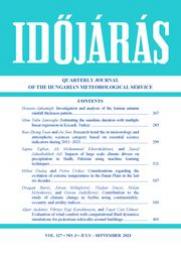IDŐJÁRÁS - angol nyelvű folyóirat
Vol. 127, No. 3 * Pages 267–420 * July - September 2023
 |
|
 letöltés [pdf: 3023 KB]
letöltés [pdf: 3023 KB]
Investigation and analysis of the Iranian autumn rainfall thickness pattern
Hossein Jahantigh
DOI:10.28974/idojaras.2023.3.1 (pp. 267–283)
Hossein Jahantigh
DOI:10.28974/idojaras.2023.3.1 (pp. 267–283)
Estimating the sunshine duration using multiple linear regression in Kocaeli, Turkey
Mine Tulin Zateroglu
DOI:10.28974/idojaras.2023.3.2 (pp. 285–298)
Mine Tulin Zateroglu
DOI:10.28974/idojaras.2023.3.2 (pp. 285–298)
Research trend the in meteorology and atmospheric sciences category based on essential science indicators during 2011–2021
Bao-Zhong Yuan and Jie Sun
DOI:10.28974/idojaras.2023.3.3 (pp. 299–319)
Bao-Zhong Yuan and Jie Sun
DOI:10.28974/idojaras.2023.3.3 (pp. 299–319)
Impacts of large scale climate drivers on precipitation in Sindh, Pakistan using machine learning techniques
Sapna Tajbar, Ali Mohammad Khorshiddoust, and Saeed Jahanbakhsh Asl
DOI:10.28974/idojaras.2023.3.4 (pp. 321–346)
Sapna Tajbar, Ali Mohammad Khorshiddoust, and Saeed Jahanbakhsh Asl
DOI:10.28974/idojaras.2023.3.4 (pp. 321–346)
Considerations regarding the evolution of extreme temperatures in the Banat Plain in the last six decades
Mihai Dudaş and Petru Urdea
DOI:10.28974/idojaras.2023.3.5 (pp. 347–377)
Mihai Dudaş and Petru Urdea
DOI:10.28974/idojaras.2023.3.5 (pp. 347–377)
Contribution to the study of climate change in Serbia using continentality, oceanity, and aridity indices
Dragan Burić, Jovan Mihajlović, Vladan Ducić, Milan Milenković, and Goran Anđelković
DOI:10.28974/idojaras.2023.3.6 (pp. 379–399)
Dragan Burić, Jovan Mihajlović, Vladan Ducić, Milan Milenković, and Goran Anđelković
DOI:10.28974/idojaras.2023.3.6 (pp. 379–399)
Evaluation of wind comfort with computational fluid dynamics simulations for pedestrian sidewalks around buildings
Alper Aydemir, Fikriye Ezgi Karahüseyin, and Yaşar Can Yılmaz
DOI:10.28974/idojaras.2023.3.7 (pp. 401–420)
Alper Aydemir, Fikriye Ezgi Karahüseyin, and Yaşar Can Yılmaz
DOI:10.28974/idojaras.2023.3.7 (pp. 401–420)
IDŐJÁRÁS folyóirat

Az IDŐJÁRÁS a HungaroMet Nonprofit Zrt. negyedévenként megjelenő angol nyelvű folyóirata
Megrendelhető a journal.idojaras@met.hu címen.
A szerzőknek szánt útmutató itt olvasható.
Megrendelhető a journal.idojaras@met.hu címen.
A szerzőknek szánt útmutató itt olvasható.









